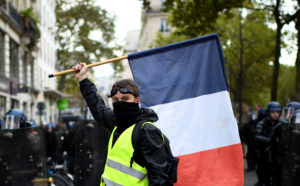The Danish filmmaker Lars von Trier probes the darkest depths of modern society, often with a deranged, comical touch. When I moved to Denmark a year and a half ago, it was reassuring for me that Lars was there, lurking in the background, in this ostensibly über-happy, self-satisfied country. At the beginning of his hilarious, low-budget 1994 TV series The Kingdom, about a haunted Copenhagen hospital where things go haywire, an ominous voice says: “Tiny signs of fatigue are appearing in the solid, modern edifice.”
Next week, Danes will go to the polls — and the country is showing tiny signs of fatigue. To the casual observer it’s not at all obvious. On an unseasonably warm October afternoon, Copenhagen is a picture of harmony: cyclists glide home along supersized bike paths after their short work days; jolly pensioners sip beer on the banks of one of the inner city lakes as fit millennials pass by on their after-work jog. A pint costs an arm and a leg, partially thanks to the country’s 25% VAT rate, the third highest in the world, but, according to the surveys at least, the Danes are happy to part with a significant portion of their income for comprehensive healthcare, low-cost daycare and world-beating welfare benefits. The caring state is largely responsible for their reputation as the “happiest people in the world”, even if the Finns pushed them down to second place in the World Happiness Report this year.
Thanks to those stellar rankings, Denmark has attracted the awe of progressives overseas, most notably during the 2016 US presidential campaign, when Bernie Sanders, to his own detriment, banged on about “democratic socialism” — you know, like in Denmark. What he meant was free healthcare and free university, traditional policies of European social democracy.
Denmark is not particularly socialist. Its economy is highly capitalist. In fact, it’s the easiest country in the world to do business. Taxes might be high, but capitalists also seem happy with the pragmatic “flexicurity model” pioneered by Social Democrats in the Nineties while the rest of the Western world was going all out neoliberal: Denmark weds a super-flexible (it’s easy to hire and fire) labour market with comprehensive retraining and generous financial support for the unemployed. The system works: in September, the unemployment rate was a minuscule 2.7%.
So where are the signs of fatigue? Quite simple: as in the rest of the world, Denmark’s resilience has been stretched by the after-effects of Covid and now the war in Ukraine and the resulting energy crisis.
The Prime Minister, Mette Frederiksen, a Social Democrat, steered the country through the pandemic with a steady hand. Showing a decisiveness that was praised at the time, she sent Denmark into lockdown before other European countries, but then was one of the first leaders to lift Covid restrictions. Denmark’s vaccination programme was extremely well organised — something I can attest to, having moved here in the middle of the pandemic from Germany, where the response was muddled and inefficient. At the time I thought: this is the well-ordered country Germany wants to be.
But Frederiksen made one fatal mistake: a rushed decision in 2020 to slaughter 17 million farmed mink after 12 Covid infections in humans were traced to infected animals. Hundreds of mink farmers were stripped of their livelihoods. The affair took a macabre turn when “zombie minks” resurfaced from mass graves, pushed up by gases released by their decomposition.
The cull was illegal, it turned out. Sofie Carsten Nielsen, the leader of the Danish Social Liberal Party, one of the “red bloc” parties supporting Frederiksen’s minority government, threatened earlier this month to stage a no-confidence vote over the mink scandal, forcing the prime minister to announce an election on 1 November, seven months before the end of her term.
How will she fare at the polls? In the 2019 election, Frederiksen came up with a new winning formula to grab power from the conservatives: get harsh on immigration. This meant, to the horror of other European social democrats, ramping up anti-refugee rhetoric, supporting the former government’s strict cap on refugees and continuing the internationally condemned “ghetto deal” — repackaged as a programme to fight “parallel societies” — to prevent a concentration of “non-Western” people in certain neighbourhoods.
Many Danes liked the message. In the 2019 election, the Right-wing populist Danish People’s Party was decimated, its support falling from 21.1% in 2015 to 8.6% in 2019. After Frederiksen took power, her government kept up the pressure on refugees and immigrants. Hundreds of Syrians, even well-integrated young adults in employment or higher education, continue to face deportation. Meanwhile, Ukrainians have been exempted from the “ghetto” policy and have been allowed to move into social housing emptied of “non-Westerners”, prompting accusations of racism.
Some measures seem particularly absurd, even sadistic, such as the “Jewellery Law”, implemented by the conservatives in 2016, but unchanged by Frederiksen. It allows police to confiscate cash and valuables from refugees to pay for their stay in Denmark. Here, again, Ukrainians have been officially exempted. The thing is: since the law was enacted, very few confiscations have actually taken place. The real purpose was to scare refugees away, it seems, not unlike ads Denmark ran in Arab media during the Syrian refugee crisis with the message: “Don’t even think about coming here. You’re not welcome.” Psychological pressure is also put on non-Western immigrants who have lived in Denmark for years to “repatriate”, as shown in a documentary by exiled Zimbabwean writer Tendai Frank Tagarira.
For Frederiksen, all this is consistent with her idea of social democracy. Recently she said: “For me, it is becoming increasingly clear that the price of unregulated globalisation, mass immigration, and the free movement of labour is paid for by the lower classes.”
In spite of her hardline stance, three Right-wing populist parties are still vying for the anti-immigration vote: the Danish People’s Party, the New Bourgeois, and the wet-behind-the-ears Danish Democrats, led by former immigration minister Inger Støjberg, who once gained notoriety by baking a cake to celebrate 50 ways she had made life tougher for immigrants. Even by Danish standards, Støjberg’s fanatical style was seen as too radical when she ordered the separation of couples in asylum centres where one partner was under 18. Parliament stripped her of her job and she was sentenced to 60 days in prison. Now her face adorns lampposts across the country. Her messaging, which includes rants against liberal, out-of-touch Copenhagen urbanites — a classic from the populist playbook — is landing the Danish Democrats around 9% in surveys.
Immigration, however, probably won’t be the big vote-winner in this election. After all, the Social Democrats’ approach doesn’t differ substantially from the Right’s policies. So what issues are resonating with voters? The sense of urgency over climate change present in 2019 has made way for fears about rising energy costs and inflation. Frederiksen is promising new programmes to dampen the economic impact on ordinary people.
Another battlefield is the growing crisis in health and social services. Thanks to poor working conditions during and after the pandemic, around 2,400 nurses are lacking in public hospitals. In an open letter, Danish surgeons expressed their fears that they are unable to operate on patients fast enough. There is also a severe shortage of workers in daycare. And other dark clouds are gathering, too: Antidepressant use is sky-high; the cancer rate is the world’s highest; young Danes are unhappier than ever; life expectancy is lower than in Germany.
After this election, unlike any Danish social democrat before her, Mette Frederiksen hopes for an alliance with the centre-Right rather than with traditional Left-wing and green allies. She says this is the best way to tackle the country’s looming problems. At 27%, her party leads the polls, but the “blue bloc” leads by Venestre (literally “Left” but actually conservative) has a good chance of governing with its Right-wing allies.
In the final scene of Lars von Trier’s 2011 apocalyptic masterpiece Melancholia, sisters Claire and Justine sit with Claire’s son Leo in a “magic cave”, a transparent teepee made of branches. The three hold hands as a giant planet engulfs the Earth. A burst of flame, a roar and then nothing. When I rewatch this scene I can’t help but think of Denmark and its anxieties. Danes still believe in their protective magic cave — no matter what the contemporary world of pandemics, globalisation, and immigration may throw at them. But change is coming, whether they like it or not.
Disclaimer
Some of the posts we share are controversial and we do not necessarily agree with them in the whole extend. Sometimes we agree with the content or part of it but we do not agree with the narration or language. Nevertheless we find them somehow interesting, valuable and/or informative or we share them, because we strongly believe in freedom of speech, free press and journalism. We strongly encourage you to have a critical approach to all the content, do your own research and analysis to build your own opinion.
We would be glad to have your feedback.
Source: UnHerd Read the original article here: https://unherd.com/



